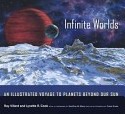Dr. Paul Rybski, UWW Dept. of Physics, will talk about “Alien Planets: What we know and don’t know about some planetary systems beyond our own” on Fri., Oct. 8 at 8 p.m. (Upham Hall 140), followed by a public viewing session at the Whitewater Observatory at 9:15 p.m. (weather permitting). This is the first of the fall 2010 Observatory Lecture Series, all of which are free and open to all!
If you’re interested in learning more about exoplanets:
 Search HALCAT (library catalog) for “extrasolar planets” to find books such as Infinite worlds: An illustrated voyage to planets beyond our sun (3rd-floor Main Collection QB820 .V595 2005).
Search HALCAT (library catalog) for “extrasolar planets” to find books such as Infinite worlds: An illustrated voyage to planets beyond our sun (3rd-floor Main Collection QB820 .V595 2005).
 Search the Library’s article databases to find articles such as “How astronomers will find another EARTH” (the cover story of Astronomy, Oct. 2010, vol.38:no.10, pp.28-33, available in the 1st-floor Current Periodicals area).
Search the Library’s article databases to find articles such as “How astronomers will find another EARTH” (the cover story of Astronomy, Oct. 2010, vol.38:no.10, pp.28-33, available in the 1st-floor Current Periodicals area).
Read the e-print of the Gliese 581g discovery article “The Lick-Carnegie Exoplanet Survey: A 3.1 M_Earth Planet in the Habitable Zone of the Nearby M3V Star Gliese 581” (accepted for publication in The Astrophysical Journal). The NASA web site provides an “artist’s conception” of the Gliese 581 system.
 And if you’re wondering about the importance of this: The “search for habitable planets outside our solar system” is one of three science objectives for 2012-2021 set by the National Academy of Science’s Committee for a Decadal Survey of Astronomy and Astrophysics (You can get a free download of the New Worlds, New Horizons in Astronomy and Astrophysics report for personal use.).
And if you’re wondering about the importance of this: The “search for habitable planets outside our solar system” is one of three science objectives for 2012-2021 set by the National Academy of Science’s Committee for a Decadal Survey of Astronomy and Astrophysics (You can get a free download of the New Worlds, New Horizons in Astronomy and Astrophysics report for personal use.).
===
Lecture Abstract from Dr. Rybski:
“On October 4th, 2010, a Lick Observatory team of astronomers led by Dr. Steven Vogt announced the discovery of the planet Gliese 581g in orbit around the cool red dwarf star Gliese 581. This planet’s mass is close to Earth’s, and it orbits Gliese 581 in the “Goldilock’s Zone“, a distance from the star within which water can exist as a solid, liquid and vapor somewhere on a planet. Other than the presence of the correct gases in its atmosphere, having water in all three of its phases on Gliese 581g is a precondition for life as we know it existing on this planet. In addition to reviewing the two observational methods by which exoplanets are found around other stars and surveying how many exoplanets have been found to date, I will present what we know about at present about the living conditions on Gliese 581c.”
